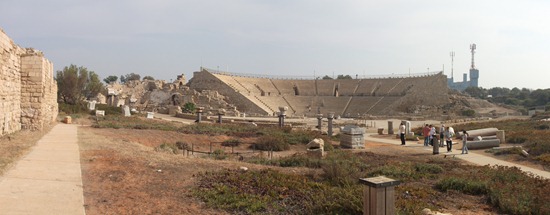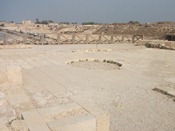The Beard Goes Home is an ongoing chronicle of my trip to Israel, Cairo and Rome from November 3-18. If you want more information on a picture, hover your mouse over it for a pop-up caption. If you want to see a bigger version of the picture, click on it.
After we visited Armageddon, Thomas and I made our way to the Mediterranean coast of Israel, to the ruins of Caesarea Maritima. It’s a beautiful ruined harbor built by Herod the Great just before Jesus was born (10-8 BCE).
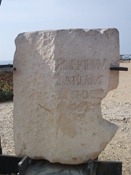 After the last of the Hasmonean kings died out, Rome conquered Israel and made Herod the Great king of Israel. Since Herod wasn’t technically Jewish, the Jews were not thrilled with this decision, and Herod spent his entire reign walking a fine line between sucking up to Rome and keeping the Jews happy enough that they wouldn’t revolt. Because the only thing Rome liked less than an unconquered territory was a territory they’d already conquered that was unruly.
After the last of the Hasmonean kings died out, Rome conquered Israel and made Herod the Great king of Israel. Since Herod wasn’t technically Jewish, the Jews were not thrilled with this decision, and Herod spent his entire reign walking a fine line between sucking up to Rome and keeping the Jews happy enough that they wouldn’t revolt. Because the only thing Rome liked less than an unconquered territory was a territory they’d already conquered that was unruly.
For all Herod’s faults, he was an incredible builder (remember – he was the one who first turned Masada into a luxurious, nearly impenetrable fortress). His dream was to create a harbor in Israel that would rival Alexandria. He came to the shores of the Mediterranean and literally created a city out of nothing. The city was a marvel of the Mediterranean – everyone who saw it agreed that Herod had accomplished his goal.
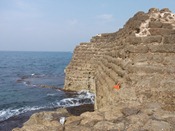 The coast had no natural harbor, no natural water breaks, so Herod utilized cutting edge technologies to create an artificial harbor. He built giant wooden boxes and floated them out onto the water. Once they were in place, they were filled with volcanic ash that, upon contact with water, hardened into a salt-water-resistant concrete. The breakwaters gradually dissolved and after a few hundred years (and a couple of earthquakes), the harbor sank. Today, you can still see the remnants beneath the waves.
The coast had no natural harbor, no natural water breaks, so Herod utilized cutting edge technologies to create an artificial harbor. He built giant wooden boxes and floated them out onto the water. Once they were in place, they were filled with volcanic ash that, upon contact with water, hardened into a salt-water-resistant concrete. The breakwaters gradually dissolved and after a few hundred years (and a couple of earthquakes), the harbor sank. Today, you can still see the remnants beneath the waves.
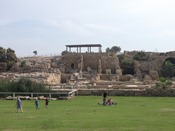 Because Caesar Augustus had made him king of Israel, Herod named the city Caesarea (Herod’s son, Philip, built his own Caesarea north of the Sea of Galilee; to differentiate between them, Herod’s became known as ‘Caesarea on the Sea’ or Caesarea Maritima, while Philip’s became Caesarea Philippi). Facing the harbor, on the highest point in the city, Herod built a temple to Roma and Augustus, his patron. As you can imagine, this infuriated the Jews, so to appease them, Herod massively renovated the Second Temple, transforming it into the largest temple complex in the ancient world for nearly 100 years (Rome destroyed it in the First Jewish War in 70 CE). After Rome was Christianized under Constantine, the Temple was leveled and a large octagonal church built in its place.
Because Caesar Augustus had made him king of Israel, Herod named the city Caesarea (Herod’s son, Philip, built his own Caesarea north of the Sea of Galilee; to differentiate between them, Herod’s became known as ‘Caesarea on the Sea’ or Caesarea Maritima, while Philip’s became Caesarea Philippi). Facing the harbor, on the highest point in the city, Herod built a temple to Roma and Augustus, his patron. As you can imagine, this infuriated the Jews, so to appease them, Herod massively renovated the Second Temple, transforming it into the largest temple complex in the ancient world for nearly 100 years (Rome destroyed it in the First Jewish War in 70 CE). After Rome was Christianized under Constantine, the Temple was leveled and a large octagonal church built in its place.
In addition to the temple and harbor, Herod also built a Circus and Theater to entertain the citizens of Caesarea. The Circus held chariot races, and possibly gladiatorial events by the end of the first century CE. Each of the buildings could hold 10,000 persons and both looked out onto the Mediterranean. Herod also built himself a massive, luxurious palace (of course), complete with a sweet-water pool for public bathing.
As the Christian movement began to spread, Caesarea played a major role. The apostle Philip moved here (Acts 8:40), and the first Gentile convert to Christianity, Cornelius was stationed here (Acts 10). Paul used the port at Caesarea frequently in his travels.
After Herod Antipas died and Rome took over direct control of Israel, the Roman governors stayed here. When Paul is brought before Festus (Acts 25), he is brought to Herod’s Palace in Caesarea. You can walk into the ruins of this room today when you visit.
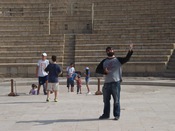 In the 600s, Caesarea fell to Muslim invaders, who leveled the 4th century church building and constructed a mosque over it. But in the 1000s, Crusaders reconquered the city and tore down the Muslim buildings, constructing a new church building and massive wall around the city. In the 1200s, a huge Muslim army
In the 600s, Caesarea fell to Muslim invaders, who leveled the 4th century church building and constructed a mosque over it. But in the 1000s, Crusaders reconquered the city and tore down the Muslim buildings, constructing a new church building and massive wall around the city. In the 1200s, a huge Muslim army 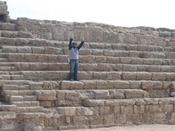 besieged the city and took it.
besieged the city and took it.
Maybe because he was sick of all the drama, that general leveled Caesarea and abandoned it. The city lay that way until it was rediscovered at the turn of the 20th century. It’s still being excavated, but it’s now also a popular vacation spot. You can fish, snorkel, swim or lay on the beach. It’s not quite the bustling harbor town Herod imagined, but it’s got a little something for everyone.
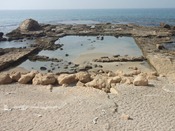 I can’t help but see Caesarea Maritima as a fascinating chapter in Israel’s history. Before Herod’s renovations, the Second Temple was a pathetic echo of the temple Solomon had built. But thanks to Herod, it became the envy of everyone who saw it. But Herod had no interest in God (remember – he’s the one who tried to kill baby Jesus!). He renovated the Temple to prop up his own political power. He knew he had to keep the Jews – well, not happy exactly, but at least not miserable enough to revolt. And so while he labored on his true passion – a monument to his own greatness – he also transformed God’s Temple into the envy of the ancient world.
I can’t help but see Caesarea Maritima as a fascinating chapter in Israel’s history. Before Herod’s renovations, the Second Temple was a pathetic echo of the temple Solomon had built. But thanks to Herod, it became the envy of everyone who saw it. But Herod had no interest in God (remember – he’s the one who tried to kill baby Jesus!). He renovated the Temple to prop up his own political power. He knew he had to keep the Jews – well, not happy exactly, but at least not miserable enough to revolt. And so while he labored on his true passion – a monument to his own greatness – he also transformed God’s Temple into the envy of the ancient world.
Of course, then Jesus said, “Tear this Temple down, and I’ll raise it again in three days.” And while all that’s left of Herod the Great is a bunch of ruined, excavated palaces, the baby he tried to kill has had a gorgeous, enormous house of worship built over every spot his followers even think he might have done something. Which is a nice commentary on what happens to the guys who trust the kingdoms they build instead of the kingdom of God, right?
